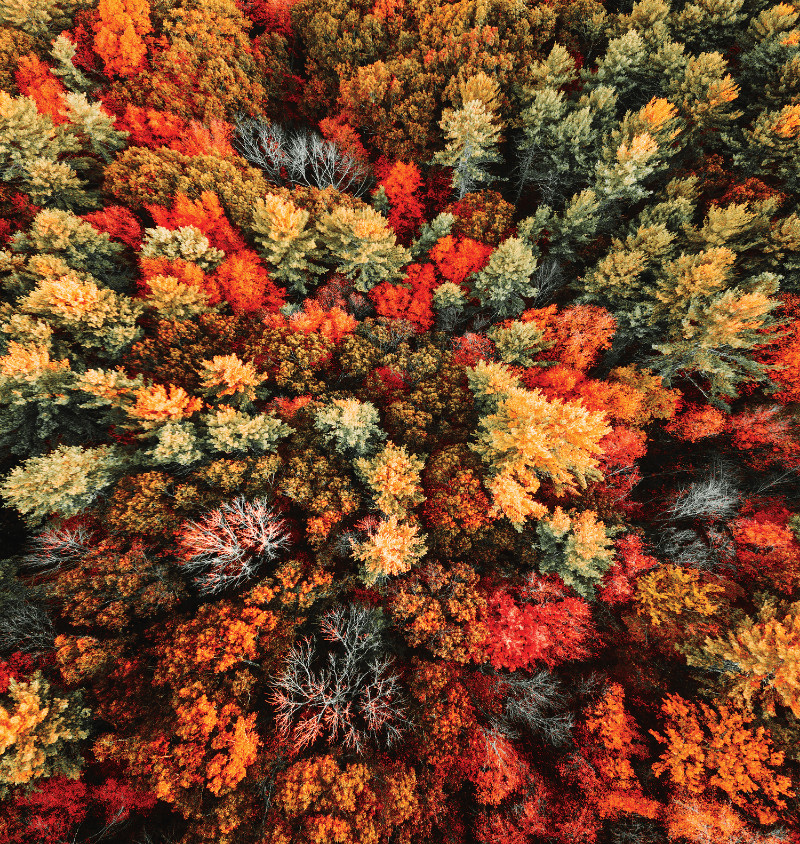TOP TREES FOR BRILLIANT FALL FOLIAGE
WRITTEN BY RONDA SWANEY
When you think of autumn color, you likely imagine a landscape filled with stately maples. There are so many varieties to consider—red, silver, sugar, Japanese. Maples may reign as the queens of color, but they aren’t the only options. Here are seven other candidates to consider when planning the fall foliage in your yard.
Ginkgo.
Every fall, ginkgo trees display vibrant yellow leaves. Plant ginkgo in full sun or partial shade so it gets at least four hours of direct sun daily. These trees aren’t huge, reaching a height of twenty-five to fifty feet and a spread of twenty-five to thirty-five feet at maturity. They grow fairly quickly, adding one to two feet annually. Be aware: in autumn, female trees drop sticky, odorous fruit that ripens on the ground and may cause a skin rash if touched. Avoid this problem by asking the experts at a nursery for help finding a male tree.
(US zones 3 to 8; Canada zone 4)
White Oak.
At maturity, these sizeable trees reach height and width from fifty to eighty feet, growing about one to two feet per year. In addition to providing red and burgundy fall colors, they also boast an abundance of acorns—a key food source for wildlife. This tree requires four hours of daily sun, so plant in full sun or partial shade.
(US zones 3 to 9; Canada zone 4)
Black Tupelo.
Black tupelos overdeliver fall color by offering a mix of red, purple, yellow, and orange on the same tree. They are on the smaller side, growing between thirty- and fifty-feet high, spreading from twenty to thirty feet, and growing about one to two feet per year. Bees love them, and beekeepers/honey producers often like to keep their beehives nearby; the result is a light-colored, mild-tasting honey.
(US zones 4 to 9; Canada zones 5 to 7)
Eastern Flowering Dogwood.
Dogwoods are landscape workhorses. They offer year-long interest with flowers in spring, bright-green leaves in summer, colorful red leaves in fall, and interesting branch shapes and bark patterns in winter. This is another small variety, reaching a height of twenty to forty feet, a spread of twenty feet at full maturity, and growing about one to two feet every year. Of all the trees on this list, these are the hardiest—thriving in nearly any level of sun or shade.
(US zones 5 to 9; Canada zones 2 to 9)
Paper Birch.
Paper birches deliver bright golden-yellow to dullish brown-yellow fall color. You can peel the bark off in layers and use it like paper (hence its name). These trees grow about one to two feet per year, reaching a height of fifty to seventy feet and a spread of thirty-five feet at full maturity. Plant these trees in full sun or partial shade, ensuring at least four hours of direct sunlight daily.
(US zones 2 to 7; Canada zones 0 to 6)
Tulip Tree.
Tulip trees add a golden glow to your fall landscape. They require sun, so plant where they can get at least six hours of sunshine daily. These tall trees reach a height of seventy to ninety feet at maturity with a spread of forty feet, and they are fast growers that add two or more feet annually. They can also be long-lived trees: a tulip tree (also known as tulip poplar) at George Washington’s Mount Vernon estate was planted in 1785, is still living, and is currently 130 feet tall.
(US zones 4 to 9; Canada zones 3 to 4)
Sassafras.
Yellow, orange, red, and purple are the autumn colors you can expect from the sassafras tree. In addition to color, these trees are known for their pleasant aroma and their bark that is the traditional flavoring for root beer. Plant them in full sun or partial shade for at least four hours of direct sunlight daily. These trees grow one to two feet per year, reach a height of thirty to sixty feet, and a spread of twenty-five to forty feet.
(US zones 4 to 9; Canada zone 5)
Photography provided by franckreporter/E+/Getty Images.
